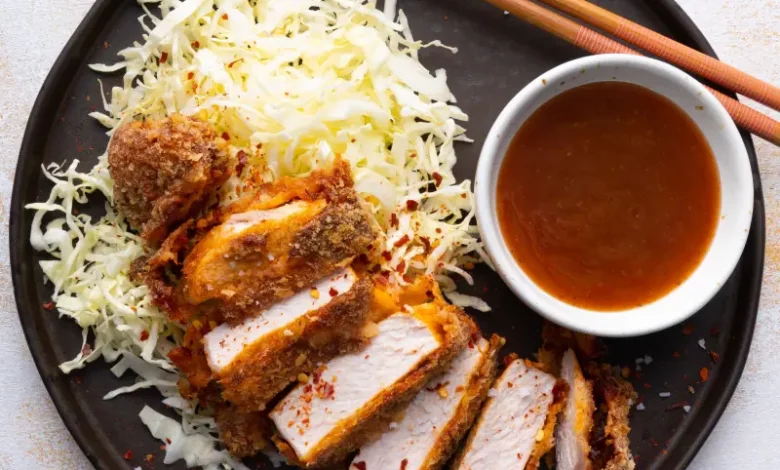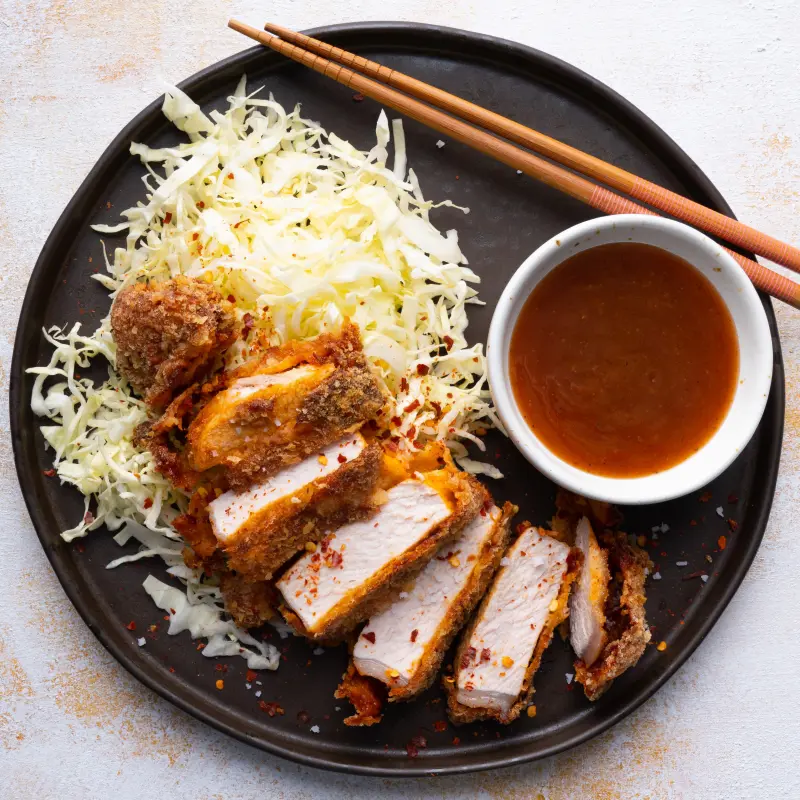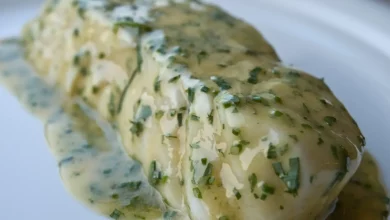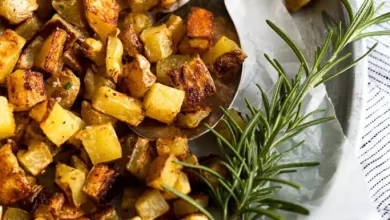Mastering the Art of Tonkatsu: Tips for Perfect Japanese Pork Cutlets

Tonkatsu, a popular Japanese dish, can be a culinary masterpiece when prepared correctly. This article will guide you through the world of Tonkatsu, addressing common questions and sharing tips for achieving that perfect sweet and juicy pork cutlet.
Contents
1. What is Tonkatsu?

Tonkatsu is a delightful dish made from breaded and deep-fried pork cutlets. The name "Tonkatsu" translates to "pork cutlet" in Japanese. It’s a beloved part of Japanese cuisine and comes in various forms, each with its unique attributes.
2. The Art of Tonkatsu Preparation
a. Choosing the Right Pork
For the best Tonkatsu, your choice of pork is crucial. Opt for high-quality, well-marbled pork like heritage breed Berkshire pigs. Avoid lean cuts that can result in dry Tonkatsu.
b. Avoid Overcooking
Tonkatsu, like a perfectly cooked pork chop, requires careful attention to cooking time. It should be cooked through but not a moment longer, as overcooking can cause the vital juices to escape, resulting in a dry and less flavorful dish.
c. Types of Tonkatsu
In Japan, specialized Tonkatsu restaurants offer variations like hire-katsu (made with pork tenderloin) and rosu-katsu (made with pork loin). You can also often choose between different breeds of pork.
3. Sourcing Quality Pork
For your Tonkatsu, consider sourcing pork from reputable sources that prioritize animal welfare and flavor. While you may not find Becker Lane Organic pork everywhere, look for similar high-quality options to ensure the best-tasting Tonkatsu.
4. Making Homemade Panko
a. What is Nama Panko?
Nama Panko is fresh Japanese breadcrumbs that play a crucial role in achieving the perfect Tonkatsu texture.
b. Preparing Nama Panko
To make nama panko, follow these steps:
- Trim crusts from the bread as closely as possible.
- Cut the denuded loaf into 1-inch square cubes.
- In a food processor, pulse a handful of cubes at a time into shaggy breadcrumbs. Avoid overprocessing for delightful crunchy bits.
- Store your processed panko in an airtight container for up to 3 days in the refrigerator or up to a month in the freezer.
5. Tonkatsu Around the World
Tonkatsu’s popularity has transcended Japan, and you can find variations and adaptations of this dish in restaurants worldwide. Whether you’re dining in Tokyo or a local Japanese eatery, Tonkatsu offers a delightful culinary experience.
In conclusion, Tonkatsu is a Japanese culinary gem, but mastering it requires careful attention to detail, from selecting the right pork to achieving the perfect panko breadcrumbs. With the tips provided in this guide, you’ll be well on your way to creating Tonkatsu that’s sweet, juicy, and truly irresistible.
> "Done poorly, Tonkatsu is a minor tragedy, but when executed with precision, it’s a real treat." – Sylvan Mishima Brackett, ‘Rintaro’
Health-Conscious Choices: Tonkatsu Alternatives
What is the traditional Tonkatsu recipe?
Traditional Tonkatsu Recipe: A Step-By-Step Guide
In the traditional Tonkatsu recipe, several key steps ensure a perfect crispy pork cutlet:
- Preparation of Pork Cutlet:
- Make incisions around the edges and into the pork cutlet to prevent curling while frying.
- Lightly tenderize the pork for an even texture.
- Coating Process:
- Coat the cutlet with a sequence of ingredients:
- Flour: Dust the cutlet with flour, providing a dry base for the subsequent coatings.
- Beaten Egg: Dip the floured cutlet into beaten egg, creating a protective layer.
- Panko: Finish by generously coating the cutlet with panko breadcrumbs for that signature crunch.
-
Frying: Deep-fry the prepared cutlet to a golden, crispy perfection.
-
Serving:
- Serve your Tonkatsu with traditional accompaniments:
- Shredded cabbage, offering a refreshing contrast.
- Tonkatsu sauce, a savory condiment for added flavor.
- A lemon wedge, providing a zesty finish.
This time-tested method guarantees a delectable Tonkatsu that’s crispy on the outside and tender on the inside.
How do I choose the best pork for Tonkatsu?
Selecting the Ideal Pork for Tonkatsu: A Guide
When choosing the best pork for Tonkatsu, you have two primary options:
-
Pork Loin (ロース, rōsu):
-
This cut offers a delightful balance of lean meat with a thin layer of fat.
-
The fat enhances the tenderness of the Tonkatsu when cooked to perfection.
-
Tenderloin/Fillet (ヒレ, hire):
-
Tenderloin is another lean choice with minimal fat.
-
It yields a slightly different texture, prized for its tenderness.
Whether you prefer the extra tenderness from pork loin or the lean, tender quality of tenderloin, both options can result in a delicious Tonkatsu. The key lies in precise cooking techniques.
What’s the secret to making crispy Tonkatsu?
The Crispy Tonkatsu Secret Unveiled
To achieve that sought-after crispiness in your Tonkatsu, follow these insider tips:
-
Panko Choice:
-
Opt for large-flake panko breadcrumbs, as they provide an authentic flavor and superior crunch.
-
Consider using a reputable Japanese brand for an even more genuine taste.
-
The Flour Trick:
-
Enhance your Tonkatsu’s coating by adding a clever touch.
-
Include a tablespoon of flour to the beaten eggs.
-
This simple addition results in a thicker egg layer, enabling more breadcrumbs to adhere.
-
The outcome? A thicker, crunchier crust that’s sure to satisfy your palate.
These secrets will elevate your Tonkatsu to a new level of crispy perfection.
Are there different types of Tonkatsu in Japan?
Exploring Tonkatsu Varieties in Japan
In Japan, Tonkatsu variations abound, each with its unique characteristics. Here’s an overview:
-
Traditional Pork Tonkatsu:
-
Made from two primary pork cuts: hire (ヒレ, tenderloin or filet) and rosu (ロース, loin).
-
Hire offers a lean and tender profile, while rosu boasts a richer, fattier taste.
-
Beyond Tonkatsu:
-
While Tonkatsu remains the most popular katsu dish, there are exciting alternatives:
-
Chicken Katsu (Chikinkatsu): Featuring breaded and fried chicken, a delightful poultry twist.
-
Beef Katsu (Gyukatsu): Enjoy the same crispy concept with beef as the star.
-
Ham Katsu (Hamukatsu): A unique variation with breaded and fried ham.
-
Ground Meat Katsu (Menchikatsu): A flavorful alternative using ground meat.
These diverse katsu dishes offer something for every palate, making Japanese cuisine an exciting world of culinary exploration.
Where can I find the best Tonkatsu restaurants worldwide?
Discovering the World’s Top Tonkatsu Restaurants
For a delectable Tonkatsu experience worldwide, consider these renowned establishments:
-
Butagumi – Tokyo, Japan: A must-visit for Tonkatsu aficionados, offering a diverse selection of pork cuts.
-
Katsukura Tonkatsu – Kyoto, Japan: Known for its meticulous preparation and outstanding flavors.
-
Tonki – Tokyo, Japan: A time-honored establishment with a rich Tonkatsu tradition.
-
Maisen – Tokyo, Japan: Famous for its crispy and flavorful Tonkatsu.
-
Tonkatsu Marugo – Tokyo, Japan: A go-to place for a classic, mouthwatering Tonkatsu experience.
-
Narikura – Tokyo, Japan: Renowned for its commitment to perfection in Tonkatsu.
-
Tonkatsu Tamafuji – Honolulu, United States of America: Offering a taste of authentic Tonkatsu outside Japan.
-
Mr. Tonkatsu – Toronto, Canada: A destination for Tonkatsu enthusiasts in North America.
Explore these establishments for a global journey into the world of Tonkatsu excellence.
What is the tradition of tonkatsu?
Unveiling the Tonkatsu Tradition
The tradition of Tonkatsu is a culinary delight that features a harmonious combination of flavors and textures. Traditionally:
-
Tonkatsu Sauce: A tangy and savory sauce elegantly accompanies the dish, enhancing its overall taste.
-
Accompaniments:
-
Fluffy Rice: A staple that complements the crispy Tonkatsu perfectly.
-
Crisp Shredded Cabbage: Offers a refreshing contrast and adds a crunchy element.
-
Miso Soup: A warm and comforting addition to the meal.
While the classic "tonkatsu" is synonymous with pork, the world of "katsu" extends to exciting variations like Chikinkatsu, which features a golden chicken cutlet. This diversity adds a unique twist to the traditional Tonkatsu experience.





